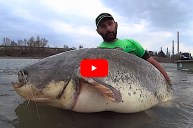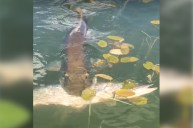The bowfin is a living fossil that is fun to catch!
When it comes to obscure fish species of North America, perhaps none flies under the radar more than the bowfin, aka: "amia calva." These unique fish do not get nearly the love of a sport fish species like bass, pike, or bluegill, but they arguably put up just as good of a fight.
Like many more obscure fish populations in the United States, this animal has an undeserved reputation as a "trash fish" thanks to its appearance, sharp teeth, and aggressive nature. This primitive fish has this bad reputation despite being here since the time of the dinosaurs and being an integral part of natural ecosystems throughout the country.
Today we will give you some facts about this cool native fish and give you a few tips to help catch your own dinosaur on the next trip to the lake.
What is a bowfin?

If you are like my dad, you may be a bit puzzled by the term bowfin. He had no idea what I was talking about when we encountered some on the local lake until I started spouting off some of the common names of this fish: "dogfish," "mudfish," "mud pike," and "grinnel" to name just a few. One of the weirder names is "cypress trout." Not sure who came up with that one, but no doubt that some of these names have helped contribute to this freshwater fish's bad reputation with anglers.
The bowfin is a throwback to prehistoric days. Scientists estimate this species has been here on earth for hundreds of millions of years. Like the snapping turtle, these guys likely watched the dinosaurs come and go from this planet. I don't know about you, but I respect the heck out of these fish just for that fact alone! Bowfin are long with a rounded and powerful tail fin that helps give this fish great strength. The thing that grabs most angler's attention is the long dorsal fin. It is extremely long, taking up nearly half the fish's length. Underwater, this fin undulates, helping give the animal the ability to move in all directions.
In a twist of unfortunate evolutionary coincidence, this fin is also what often leads to this species being mistaken for the Northern snakehead, a species native to China, Korea and Russia that has spread in the United States, bringing destruction to native habitats with it. As a result, many anglers have needlessly killed a completely native fish thinking they were doing the right thing. One key thing to look at is the fish's anal fin. On a snakehead, this fin is elongated like the dorsal fin, but on a bowfin, it is much shorter.
Bowfin also have a pectoral fin that is situated in a forward position from the fish's pelvic fin. Snakeheads have this fin situated horizontally and just above the pelvic fin. Another tell-tale sign of a bowfin is the black spot situated on the fish just before the tailfin. It often has a brightly-colored ring circling it on male bowfin. The overall coloration of the bowfin varies greatly depending on where they are found and the time of year. Most have a brown or black appearance while others can take on a green or olive-green appearance. I have seen photos online of specimens that have a vibrant lime green or even yellow coloration that no doubt confuses some of the anglers who catch them even more.
But wait, there is more! This is a truly fascinating fish species that is full of surprises. One of which is that the large mouth and jaws contain many rows of razor-sharp teeth that are not immediately obvious when you catch one. My friend once had to stop his brother from trying to lip the lower jaw of one because he did not realize those teeth were there.
This fish also possesses the ability to gather oxygen from both water and air like many gar species. It is not uncommon to see one come to the surface and gulp air in less oxygen-rich waters. It can then store this oxygen in an air bladder for later. I have heard stories about these fish surviving for extremely long periods out of the water as a result.
Range, habitat, and diets of bowfin.

According to the U.S. Geological Survey, this fish has a range that is centered mostly in the Midwest and southeastern United States. They are abundant throughout Michigan and in all the Great Lakes. Their native range extends as far north as Minnesota, New York, and parts of Canada. Bowfin are extremely common throughout the length of the Mississippi River all the way down to the Gulf of Mexico. These fish are found in parts of Indiana, Missouri, Iowa, Tennessee, and Kentucky. They are also found throughout Louisiana, Mississippi, Alabama, Georgia, Florida, North Carolina, and South Carolina. Their range does not extend very far west, only reaching parts of eastern Oklahoma and Texas at the furthest.
As for habitat, we already mentioned how this fish can get oxygen from both air and water. That gives it a huge advantage over most common game fish species in terms of places to live. The bowfin can survive in oxygen-starved swamp backwaters, sloughs, ponds, and streams that other fish cannot. They do tend to prefer vegetation-rich environments that give them ideal places to ambush their prey.
Simply put, waters that may be inhospitable to other species of fish may just be a bowfin hotspot if they can provide ample food. Speaking of a bowfin's diet, this fish species is not known for being too picky. They will basically eat whatever they can find the easiest. Often on the menu are aquatic insects, minnows, shad, and crayfish. However, bowfin have also been known to eat worms, frogs, mice, and more. This is part of what makes them incidental catches for many anglers. These fish are as apt to strike a child's nightcrawler suspended beneath a bobber as they are a bass pro's spinnerbait as they work it above the grass.
How big do bowfin get?
From my own research, most state records for this species tend to fall in the 12-15-pound range. Here in Michigan, the state record is 35-inch, 14-pounder caught out of Livingston County's Crooked Lake back in 1981. The size of the species seems to be affected by region much like largemouth bass. Southern states seem to produce larger specimens. Florida's record is a 19-pounder. In most areas, a bowfin measuring 25-30 inches are considered a large catch. Most fish in that length range tend to fall in the eight to ten-pound range.
While the records for this species do not get a lot of attention, the International Game Fish Association does recognize many line class records and an all-tackle world record. A handful of dedicated anglers have cemented their names in the book many times as a result. The all-tackle world record for the biggest bowfin ever caught officially is a monstrous, 21-pound, 8-ounce fish caught by Robert Harmon in South Carolina back in 1980.
The bowfin is a solid species to look at if you are looking to get your name in your state's record book. I have read numerous stories of anglers who have caught fish that likely would have broken the record, but they had no idea what species they had caught until they went home and looked it up later. In many states, no one has even attempted to enter a new record in years, making them a prime target for record seekers.
How to fish for bowfin.
As we have already noted, this species has a wide diet and that makes them susceptible to a variety of presentations and angling methods. Some anglers swear by live minnows or cut bait suspended beneath a bobber. I have personally had them strike everything from plastic worms to spinnerbaits. They can be sight-fished when they are in the shallows. Keep a variety of lures tied on to multiple setups because their aggressiveness can vary by the day. Sometimes they just will not strike until you drop something slow-moving right in front of their face. Other times, you will not be able to keep them off your lure. A good leader to prevent them biting through your line is not a bad idea either.
Bowfin are a great species to target during the dog days of summer when other anglers are bored and sitting back at the dock in the shade. This species may strike your lures on hot, sunny days when every other fish in the lake has an extreme case of lock jaw. While you can catch these fish at any time, they are also quite active at night, making that a viable option if you are looking to catch a trophy.
In the spring, when bowfin spawn, keep an eye out for black "balls" of young bowfin in the shallows. Bowfin will aggressively defend their young, making spawning fish easy to catch. Because they are adaptable to nearly any type of water, you can catch them almost anywhere. I have targeted bowfin both from a boat and from the shore. Sometimes I will do some bridge-hopping drives from roadside spot to spot along rivers, sight-fishing them as I go.
One thing to keep in mind through all this is that the bowfin is a native fish species and it is not nearly as destructive to native game fish populations as some anglers will lead you to believe. You should not feel pressured to kill them unless you really want to cook them. I should note that reviews on bowfin as an eating fish are mixed at best. If nothing else, the bowfin is a unique and exciting native species to target, especially if you have already mastered catching every other species in your area. Consider giving fishing for bowfish a try the next time you head to the lake or river!
For more outdoor content from Travis Smola, be sure to follow him on Twitter and check out his Geocaching and Outdoors with Travis YouTube channels.
NEXT: THE AXIS DEER, AND HOW THEY'RE IMPACTING PARTS OF THE UNITED STATES
WATCH





